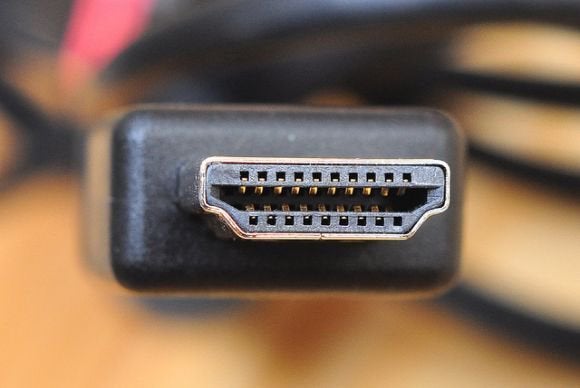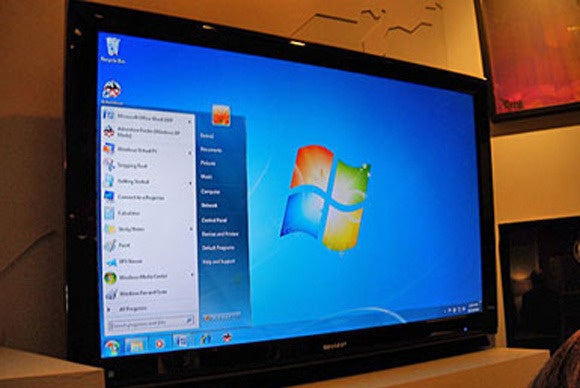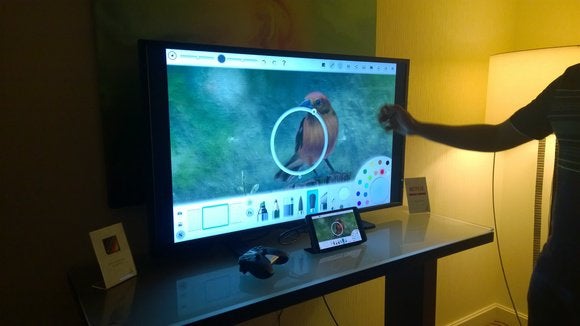Use your TV as a computer monitor: Everything you need to know
 Wednesday, June 14, 2017 at 12:22AM
Wednesday, June 14, 2017 at 12:22AM A couple of months ago, I took a good, hard look at my dual-screen setup and thought, hmmm, maybe I should get another monitor. A bigger monitor. Then, after an hour or two of researching 27-inch monitors online, I walked into my living room and was struck with a brilliant idea: Maybe, instead of purchasing an entirely new monitor, I should just move my 32-inch HDTV into my office and call it a day.
Bigger is better, you know, and this way I wouldn’t have to drop a couple hundred bucks on a new piece of equipment. But just because HDTVs look a heck of a lot like computer monitors doesn’t necessarily mean they can replace computer monitors. Or does it? Here’s what you need to know if you’re thinking about sticking an HDTV on your desk.
Will it even work?
The short answer: Yes, although you may need a special cable depending on what type of input/output ports you’re working with.
All modern HDTVs have HDMI inputs—some older HDTVs have DVI inputs instead—and some have VGA inputs for “PC use.” If your graphics card has an HDMI output, you’re good to go: Just use an HDMI cable to connect your PC to your HDTV. If your graphics card only has DVI outputs, I suggest snagging a cheap HDMI-to-DVI cable (like this one on Amazon) and plugging it into your HDTV’s HDMI input. Although some HDTVs (and some graphics cards) have VGA inputs/outputs, this is not the ideal choice—it’s an analog signal that will give you a far fuzzier, lower-resolution image than an HDMI or DVI signal.

An HDMI connector.
If you’re setting up your HDTV as a second or third monitor, you may need to use your PC’s DisplayPort output, in which case you can purchase a DisplayPort-to-HDMI converter (like this one) and plug into your HDTV’s HDMI input. The main advantage to converting from DisplayPort is that HDMI and DisplayPort both carry sound as well as video—if you use DVI (even the digital version) or VGA, you’ll need to connect your PC’s sound to the HDTV or to external speakers separately.
Before you start using your HDTV as a monitor, you need to figure out whether your graphics card/integrated graphics is capable of outputting at the resolution of the HDTV. To do this, you’ll first need to find the resolution of the HDTV by consulting the manufacturer’s manual. Be aware that some HDTVs have non-standard resolutions. Then, find your graphics card’s maximum resolution by going to Control Panel > Display > Change display settings > Advanced settings > List All Modes. Find the resolution that matches your HDTV and select it.
Will it look good?
Maybe, but this depends on a number of factors, including what you want to use your HDTV monitor for. Most reasonably priced HDTVs top out at 1080p, or 1920x1080 resolution. On a 15.6-inch laptop screen, the Windows desktop at 1080p looks pretty darn good from a couple of feet away. On a 32-inch HDTV screen…not so much.

What’s important here is pixel density, or the number of pixels packed into one square inch of the screen. A 15.6-inch laptop screen has the same number of pixels as the 32-inch HDTV screen, but the laptop has a much higher pixel density (141.21ppi) than does the HDTV (68.84ppi). Thus, the laptop’s screen will appear clearer, sharper, and more detailed than the HDTV’s screen when viewed from the same distance. The importance of pixel density decreases with viewing distance; that’s why the iPhone’s “Retina” screen has a density of 326ppi, while the MacBook Pro’s “Retina” screen has a density of just 227ppi.
What this means for you is that a larger but less pixel-dense HDTV screen will display text, icons, and images as blurry and difficult-to-read if you’re sitting at a normal viewing distance—a couple of feet—from your computer.
If you plan on using your HDTV monitor to do anything other than watch Netflix or play games, you’ll want an HDTV with a higher pixel density (I like to shoot for at least 80ppi, which means no larger than a 27-inch screen at 1080p) for comfortable viewing. Or just hang it on the wall rather than plopping it on your desk.
Speaking of gaming, if you want to use your HDTV monitor to play games, there’s another factor you’ll need to take into consideration: input lag.
Input lag is the delay between movement you make on your input device (in this case, your mouse) and what displays on your screen. While many computer monitors prioritize minimal lag times, many HDTVs do not, and prioritize (laggy) video processing instead. But those extra milliseconds will definitely make a difference when you’re playing a high-stakes FPS.
DisplayLag has a pretty good database of input lag times that you can sort by display type—you want to pick an HDTV with a lag time of no more than about 40 seconds. If you run in to input lag problems while gaming, try activating your HDTV’s “Game mode” setting if one is available.
Is it worth it?
If you’re looking to get the best bang for your buck, an HDTV isn’t necessarily going to save you money over a monitor. In fact, if you’re purchasing a new display, I recommend sticking with the tried-and-true computer monitor. For one thing, smaller, cheaper HDTVs are typically 720p resolution, not 1080p, while similarly priced monitors will almost always be 1080p. So if you’re looking for something under 27 inches, an HDTV will probably be more expensive and lower-resolution.
If you’re looking for something larger than 27 inches, remember that pixel density decreases significantly with every few inches you gain, and there’s a reason HDTV-makers suggest sitting several feet away from their displays. If you need a display that will multitask as an up-close work/email display as well as a movie/entertainment display, you’ll want something with a high enough pixel density that text won’t be a pain to read.
There is an ideal situation in which the HDTV-as-monitor shines, though.
If you want to add an extra display to a single- or multi-display setup for entertainment—say, so you can watch Netflix or Twitter while you write articles, or so you can play Skyrim on a 60-inch screen—then an HDTV can be a very capable (and cool!) monitor replacement. Bonus points if you happen to have an extra HDTV lying around, or if you can pick one up for dirt-cheap.

Reader Comments